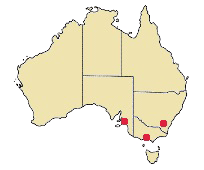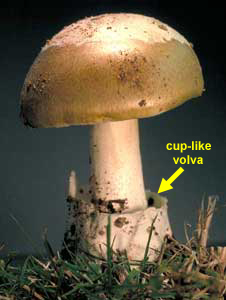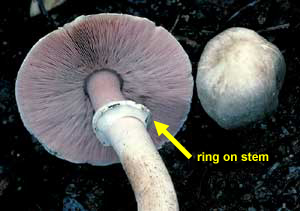Deathcap Mushroom
Amanita phalloides
|
In a poisoning emergency phone 13 11 26 24 hours a day, 7 days a week, |
You may reproduce the Deathcap information and photos, in any form and free of charge, for any non-profit community or health purposes. You don’t need to ask for permission - but we’d like you to acknowledge that you found it here.
How dangerous is the Deathcap?
Deadly! The poisons in one cap are enough to kill a healthy adult and less will be enough to kill a small child.
What should I do if I’ve eaten one?
Go to a hospital immediately. If possible, take a sample of your mushroom with you.
Is there any way to remove the poisons from the mushroom?
No. The poisonous compounds are extremely stable. You cannot remove them by soaking, cooking or drying. The poisons are found throughout the cap, gills, stem and spores.
What does it look like?

Major features:
Smooth, yellowish-green to olive-brown cap; white gills; white stem; membranous skirt on stem; cup-like structure around the base of the stem.
A more detailed description:
Cap: The young caps are close to hemispherical in shape but then flatten as they expand. When fully open they are gently curved and smooth. The colour is usually yellowish green, but may sometimes be olive to light brown. The fully open caps are commonly 10-15 centimetres in diameter. However, you can find fully mature Deathcaps with caps under 10 centimetres across, occasionally even as little as 5 centimetres. Much depends on what the weather has been doing. The cap is slightly sticky in wet weather but dry and shiny in dry weather.
Gills: White. The gills don't reach the stem, but come close.
Stem: The stem is white and from 5 to 15 centimetres long and 1 to 2 centimetres in diameter. The base of the stem is bulbous (up to 4 centimetres in diameter) and is contained within a cup-like structure (called a volva). Sometimes the bulbous base and the volva will be partially buried in the soil or hidden by grasses and leaf litter. Occasionally the volva is poorly developed.
Here are two young specimens, the caps not yet fully expanded, showing the cup-like volva at the base of the stem.
There is usually a loose, white, skirt-like membrane (called a ring) around the upper part of the stem, but it’s not too hard to rub off this ring if you handle the mushroom roughly. At an earlier stage that membrane would have stretched from the stem to the edge of the cap and covered the young gills.
Here is an illustration showing how a Deathcap mushroom develops.
Flesh: White
Spore print: White (See the SPORE PRINT SECTION if you’re not sure what a spore print is.)
Universal veil: When the Deathcap is still fairly small, it is wrapped up in a smooth, white skin - called a universal veil. As the stem lengthens and the cap expands, the Deathcap breaks through that veil. The cup-like volva at the base of the stem is a remnant of that universal veil. For a short time a part of the universal veil may stay on the cap as a white patch, but this soon disappears. The photos show such patches on some of the smaller mushrooms that have not yet fully developed.
Don’t confuse the Deathcap with the Straw Mushroom.
The Straw Mushroom (Volvariella volvacea) is grown and eaten
through a large part of Asia but it does not grow naturally in Australia. However
the species Volvariella speciosa is found naturally in many parts of
Australia and looks very similar to the Straw Mushroom. Each species in Volvariella
has a volva at the base of the stem and the gills don’t reach the stem
- just like the Deathcap. However, in Volvariella there is no ring on
the stem and the gills are pale pinkish-brown, rather than white. Moreover,
the cap is more brown to greyish and more-or-less conical. However, you could
easily overlook some of these differences in a hasty examination and much depends
on the weather. Just to prove that point, here is another photo ![]() ,
taken in Canberra, showing a Volvariella speciosa and a half-open Deathcap.
There were several specimens of each species growing together, in a small parkland
area. The photo was taken a day after heavy rain, so both mushrooms have been
battered by the weather. Can you pick the Deathcap?
,
taken in Canberra, showing a Volvariella speciosa and a half-open Deathcap.
There were several specimens of each species growing together, in a small parkland
area. The photo was taken a day after heavy rain, so both mushrooms have been
battered by the weather. Can you pick the Deathcap?
The young Volvariella speciosa shows a well developed volva ![]() .
Compare this with the young Deathcap pictures above.
.
Compare this with the young Deathcap pictures above.
If you have migrated from Asia, or are otherwise familiar with the Straw Mushroom, you could accidentally pick a Deathcap, thinking it is the harmless Straw Mushroom. In one Canberra case, three Laotians made this mistake and the same mistake has also been made in New Zealand and the USA.
Could I confuse the Deathcap with anything else?
You shouldn’t confuse it with any of the ordinary field mushrooms (in the genus Agaricus), where the gills are pink at first but eventually turn brown. Mushrooms in the genus Agaricus also have a ring on the stem, but no volva at the base of the stem. Here are the undersides of a couple of Agaricus species, showing pink and brown gills.
When the Deathcap is still very young, it is enclosed in a smooth, white skin. You could initially mistake this stage for an immature puffball, since many puffballs are white when young. However, while an immature puffball has solid white flesh inside, a young Deathcap will show the stem and gills. This photo, of a young Deathcap cut in half, shows this. On the right is the outside appearance and on the left is the inside - showing the young stem and gills.
What are the symptoms?
The symptoms are slow to show themselves and often do not appear until 10-16 hours (or even longer) after eating.
The timing given above is approximate, for much depends on the general health of the individual and how much they’ve eaten. For example, if you’ve eaten a large meal of Deathcaps the symptoms could start as early as 6 hours after the meal.
The first symptoms are stomach pains, vomiting and diarrhoea. These may continue for a day or two, after which there is typically an easing of symptoms and apparent recovery. The "recovery" period may last for 2 or 3 days. Then the terminal phase of 3-5 days starts with the re-occurrence of stomach pains, vomiting and diarrhoea - accompanied by jaundice. Without effective, early medical intervention, coma and death occur between one and two weeks after eating the mushroom. Death is caused by liver failure, often accompanied by kidney failure.
 Where is it found?
Where is it found?
The Deathcap is common in many Canberra suburbs and can be found in most autumns near oak trees, with which it forms a symbiotic association. It is also well-established in several Melbourne suburbs and in some Victorian country towns near Melbourne. In July 2008 the Deathcap was found in Adelaide, at the Waite Arboretum in Urrbrae.
It is not native to Australia, but has been accidentally introduced from the northern hemisphere.
There is some evidence of it associating with eucalypts in Canberra, but this needs further study. It has been reported from eucalypt and acacia plantations in east Africa, and eucalypt plantations in Morocco.
How do the poisons work?
The nucleus of a human cell contains the DNA that is, in effect, the instruction book for the cell and tells it how to work. The deadly compounds within the Deathcap stop the cell reading its own instruction book and the cell dies. If enough cells in a human liver or kidney are effected and die, then there will be catastrophic liver or kidney failure - and then death.
You can bring up a more detailed, technical explanation by clicking this button.
![]()
References
Canberra Times - Saturday 2 November 2002 - article on a Canberra death caused by consumption of Amanita phalloides PDF
Benjamin, DR. Mushrooms: Poisons and Panaceas, WH Freeman & Company, New York, 1995.
Benjamin, a professional pathologist and amateur mycologist, has written a very readable account of the poisonous fungi and their poisons. While some sections require some medical knowledge (or a nearby medical dictionary) the bulk of this book can be read by non-medical people. Highly recommended for anyone who has to deal with cases of mushroom poisoning or is curious about poisonous mushrooms.
Bresinsky, A & Besl, H. A Colour Atlas of Poisonous Fungi. Wolfe Publishing, London, 1990
This is written at a more technical level than the book by Benjamin and is aimed at pharmacists, doctors and biologists. There are detailed descriptions (using macroscopic and microscopic features) of many poisonous species as well as photos showing both naked eye and microscopic features. The book also contains details of the toxic compounds and discussions of symptoms and treatments.
Southcott, RV. "Mechanisms of macrofungal poisoning in humans" in Fungi of Australia, Volume 1B, Australian Biological Resources Study, CSIRO Publishing, 1996.
This chapter gives an overview of the poisonous fungi in Australia.
ACT Health information
This is a link to information prepared by the ACT health department.
http://www.health.act.gov.au/publications/fact-sheets/death-cap-mushrooms
Poisoning by Amanita phalloides ("deathcap") mushrooms in the Australian Capital Territory
This web site takes you to a medical report on the Deathcap poisonings in the ACT, between 1988 and 1998.
http://www.mja.com.au/public/issues/171_5_060999/trim/trim.html
Mushroom toxins
This specialist site, maintained by the US Food and Drug Administration, contains technical information about mushroom poisons.
http://www.fda.gov/downloads/Food/FoodborneIllnessContaminants/UCM297627.pdf
![An Australian Government Initiative [logo]](/images/austgovt_brown_90px.gif)









